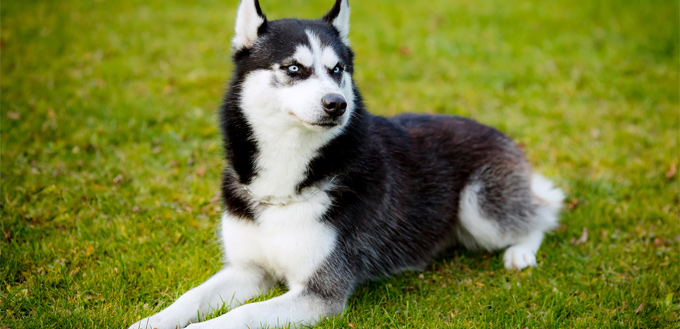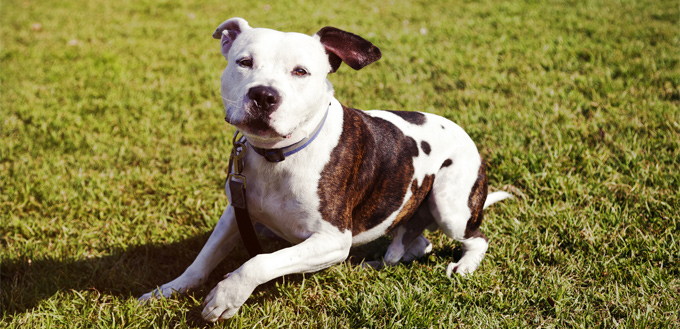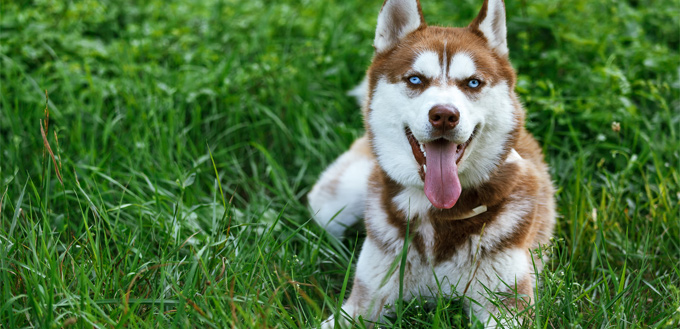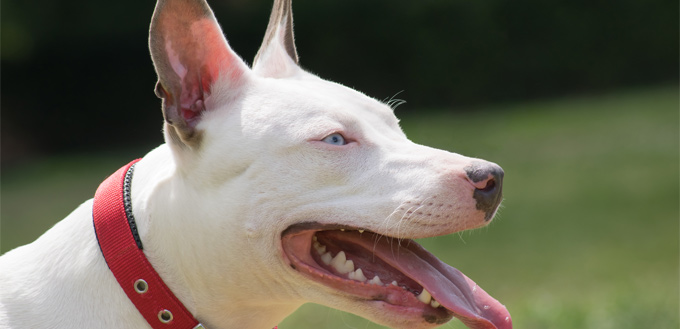One is often depicted as a very ferocious dog while the other one is often likened to a wolf. One is often misunderstood, but is actually one of the most affectionate, most loyal, most obedient, and friendliest hounds on the planet. The other is very friendly, too. When you create a cross of the Pit bull terrier and the Siberian husky you’re bound to get a very interesting mix – very loyal to its family, a friend to everyone, and a loving and affectionate large lap dog. The Pitsky is here to charm you with its unquestionable loyalty and very infectious friendliness.
History of the Pitbull-Husky Mix
No one can be absolutely certain about the exact origins of the Pitbull Husky crossbreed. One thing is certain: the Pitsky is not a new designer breed.

A review of literature revealed quite a number of questionable observations. For example, everyone knows that the Pitsky is a combination of an American pit bull terrier and a Siberian husky. However, we also found that some dog designers actually cross a Pitbull with an Alaskan husky. This is where the question lies.
According to the AKC, the Alaskan husky is not actually a breed of dog, but rather a classification of dog that refers to those that work as efficient sled dogs. While the Alaskan husky has many striking resemblances to the Siberian husky, it is much leaner and is specifically bred for sled dog racing as well as for carrying other tasks that the people of the North expect from their dogs.
For it to be considered a Pitsky or a Pitbull Husky Mix, it is imperative that the parents are an American Pit Bull terrier and a Siberian husky. This is the only way you can somehow make more accurate estimates as to how your Pitsky will turn out, considering that 50% of it will come from the pitbull while the other half will come from the Siberian husky.
If you do get a Pitsky that’s a combination of an American pit bull and an Alaskan husky, you’re only guaranteed 50% pit bull. As for the other 50%, you’d have to identify what specific breeds are present in the Alaskan husky that was used in the crossbreeding. Remember, the Alaskan husky is NOT a dog breed.
Who are the Parents?
The sad thing about crossbreeds is that there’s no 100% foolproof way to determine how the puppy will turn out. One can only make assumptions based on the characteristics of the Pitsky’s parents. Unfortunately, if one of the Pitsky’s parents is not also purebred, then the more that it will be difficult to predict how the Pitsky will grow up. While looking at the characteristics of the parents can help, know that this will only be applicable to purebred dogs.
American Pit Bull Terrier
One of the most misunderstood hounds of all time, the American pit bull terrier has always been depicted in the media as a vicious, super-aggressive, and very mean dog that does nothing but to attack people and other pets. On the contrary, it is one of the most loyal dogs you can ever find. Just ask Cesar Milan, Rachael Ray, Jennifer Aniston, Jessica Alba, and a bunch of Hollywood A-listers what they think about their beloved pit bulls.
Affectionate and very friendly, the pit bull is a loving pet that is never afraid to show its love and commitment to those who give it the correct mix of training, socialization, and affection. It is strong-willed and very courageous, traits that some people mistake for aggressiveness. It’s highly intelligent and very obedient dog, too, allowing them to be easily trained. They may be a bit stubborn, but in the hands of a firm and able pack leader, the Pit bull will never falter as a loyal member of the pack. Be careful, though. Behind the serious face of a Pitbull is a very clownish nature.
The Pitbull was the product of breeding an Old English bulldog with an Old English terrier to come up with a dog that has the athleticism and strength of the bulldog and the gameness and flexibility of the terrier. They were especially bred for the purpose of bear beating and bull baiting which were officially abolished in the UK in 1835. However, this has not prevented Pitbull breeders from using the dog in clandestine bloodsport events, continuing well into the early parts of the 20th century.
Because the origin of the Pitbull was more as a fighting dog, many individuals look to them as very aggressive. What they fail to understand is that the dog is actually very stable and highly resilient. It is also very friendly to people. The dog is used as a companion dog, a therapy dog, a service dog, and even a guard dog. They love playing with kids and adults alike. In fact, Pitbulls absolutely hate being left alone. It thrives on social interaction. They love some cuddling even though their size won’t allow it.
Pitbulls may be a resilient breed, but they’re vulnerable to allergies, hip dysplasia, demodectic mange, and even hypothyroidism. As such it is imperative that dog breeders of Pitskies should keep in mind the health of the parent pitbull.
On the average, a pitbull can grow up to 85 pounds and about 17 to 21 inches. They’re known to last as long as 16 years.
You may also like our article on Pitbull Puppies for Sale.

Siberian Husky
Called Siberian Rats by the people of Nome, Alaska because of their smaller size compared to the bulkier Malamute, the Siberian husky is a very ancient dog that may have thrived as early as 8,000 years ago. Scholars believe that the husky was bred by the ChukChi people in Siberia specifically for pulling sleds over the harsh snowy terrain.
Known for its outgoing yet gentle personality, the husky is very friendly around kids having spent most of its time indoors with its family when it is not outside pulling sleds. It is one of the direct descendants of the Taymyr wolf, a subspecies of the great Grey wolf of the Nordic world. It is highly valued for its speed, agility, endurance, and resilience that it is preferred to the Malamute when it comes to racing across the snowy terrain.
As a matter of fact, the Siberian husky is well known for its endurance that a bronze status is actually erected in New York City’s Central Park honoring the Siberian husky who led the team of sled dogs to deliver diphtheria serum over 600 miles across treacherous lands, Arctic blizzards, and rough ice from Nenana to Nome in Alaska in February 1925. Through the decades the husky has been the venerable companion of many explorers in frigid environments like the Arctic and Antarctic. No one can question the dedication of these dogs.
The Siberian husky is affectionate and happy. It is a working dog and as such loves the challenge of having to work for something. It does shed a lot, though, and has the tendency to bark. It is intelligent but can show its stubbornness to someone it perceives not deserving of its true power.
Hip dysplasia remains a major cause of concern among Siberian huskies despite being able to live up to 15 years. These 60-pound 20 to 23.5-inch dogs are also prone to corneal dystrophy, cataracts, and progressive retinal atrophy that can lead to permanent loss of vision.
Take a look at our review of Dog Foods for Huskies.
Quick Facts
Even if you manage to get a purebred pitbull and a purebred Siberian husky to mate, there’s still no guarantee that the characteristics you’ll see in your Pitsky will be the same as what other Pitskies have. This is one sad fact of life about hybrids or crossbreeds that potential dog owners simply have to learn to accept. Nevertheless, here’s what we know about the Pitsky.
- The average Pitsky can stand as tall as 24 inches or as short as 19 inches, although it is not unusual to see dogs that have measurements well outside this range.
- Pitskies can weigh anywhere between 30 pounds and 70 pounds. The variability is greatly dependent on whose parent’s genes are more dominant when it comes to coding for the dog’s weight. Pitbulls are stockier and heavier while huskies are generally leaner and lighter by a few pounds.
- The Pitsky has interesting parents. One is short-haired while the other has dense, double coat. You can just imagine who between its parents has a more dominant gene when it comes to the Pitsky’s coat. If it’s short-coated, then it’s from its Pitbull parent. If it’s long-haired and double-coated, then expect it from the Husky parent.
- Both parents of the Pitsky are highly energetic dogs. Expect plenty of dog exercises; otherwise, you’ll meet a lot of behavioral problems because of boredom.
- The Pitsky hates being left alone. If you intend to get one, make sure you have plenty of time to interact with it and give it the attention it needs. If not, then be ready for the consequences.

Things You Should Know
Before you bring home a Pitsky, make sure you understand a few basic things about them:
Training
The parents of the Pitsky are both intelligent breeds. However, don’t assume that your dog already knows what you want. All aspects from housebreaking to potty training your dog and basic obedience training and everything in between should be started as soon as you get the Pitsky to your home. On a positive note, the Pitsky is very quick to learn especially if you’re familiar with the basics of dog training such as the application of rewards-based training principles like positive reinforcement.
Do take note that the Siberian husky in your Pitsky can overwhelm the Pitbull inside. What this essentially means is that you’ll have a dog that is definitely stubborn to teach. Don’t get us wrong. The husky is intelligent. It just wants to know if you’re fully capable of being its pack leader. Firmness and consistency are the keys when appealing to the Husky in the Pitsky; otherwise, you’ll be better off with a professional dog trainer.
Feeding
Pitskies are highly active hounds. They love to play and exercise. They can be classified as medium to large dogs and as such should be given the right amounts of calories that are appropriate for their weight and activity level. They need high quality proteins as the principal ingredient in their dog food – animal proteins, not plant proteins. High protein food should help ensure their muscles are well-built.
You may also want to take heed of their parents’ health predispositions. Both Husky and Pitbull are prone to hip dysplasia. Giving your Pitsky dog food that comes with glucosamine and chondroitin should be helpful. Allergies are also characteristic of Pitbulls so you might want to start your Pitsky on a limited ingredient diet before adding new ingredients after a few months or so.
Exercise
The Pitsky has a more or less muscular build, owing to the fact that its parents are both working dogs. That being said, the Pitsky requires at least an hour’s worth of walk or 30 minutes of intense exercises in addition to 15 minutes of mental stimulation. These are crucial to prevent canine boredom which is one of the root causes of many behavioral problems in dogs.
If you’re not going to exercise your Pitsky, just be ready with a host of behavioral problems not to mention obesity and its accompanying health complications.
Socialization
While it’s true that both the Pitbull and the Husky are naturally friendly to people, they must be introduced to different kinds of individuals, both young and old alike so they will have an idea of what it means to be a socially well-rounded dog. Dog parks and local dog activities offer the best chance for your Pitsky to mingle with other dogs as well as other people, although inviting guests over for dinner wouldn’t hurt, too.
Grooming
Depending on the type of coat that your Pitsky may have, you will need daily brushing if the coat is long and dense or a weekly brushing if it’s generally short. Brushing your dog’s teeth should be done every day; at least once a week if not possible. Trimming or clipping the nails should be done as needed. If you hear the claws clanging onto your floor every time your dog walks, that’s usually a good sign that it’s up for nail trimming. Cleaning the ears can be done twice a month while bathing can be done every month if it’s a long-coat, or every two months if it’s a short coat.
Health
The Pitsky may have very resilient parents, but that’s not an automatic ticket to a disease-free life. This crossbreed is also predisposed to a number of health conditions like its parents and these can include hip dysplasia, hypothyroidism, demodectic mange, allergies, eye problems, and heart problems. It is often imperative that the parents of the Pitsky be free from any of these conditions to help guarantee a healthier crossbreed.
The Pitsky is a great dog for those who have the following characteristics:
- Families with children who are at least 6 years old
- Individuals who lead an active lifestyle
- Folks who can devote at least an hour of exercise every day and 15 minutes of mental stimulation
- Persons who don’t mind training and socializing Pitsky puppies early on
- Folks who can commit to providing high quality dog food
- People who can groom their pet on a regular basis
- Pet parents who will never leave their dog alone in their home for more than 6 hours at a time
The Pitbull Husky Mix is not generally recommended for those who may have the following characteristics:
- Cannot devote 30 minutes of socialization, pet parent-dog interaction on a daily basis
- Have to leave the dog alone for longer than 6 hours at a time
- Hate exercising or going outdoors
- Hate grooming, trimming the nails, brushing the teeth, and cleaning the ears
- Have no idea about the basic principles of dog training

Temperament
The Pitbull Husky mix is a very loyal dog. Train it well and it will love you for the rest of its life. Sadly, its loyalty can easily cross the boundary of being overprotective. If it senses that one of its family members is being threatened, it will never hesitate to defend its family. Its loyalty is unquestionable. However, early training is needed to teach your Pitsky the difference between loyalty and overprotectiveness.
Pitskies love to play outdoors. Come rain or shine there’s nothing that they’d rather do than frolic outside. The predatory instinct of the Husky is very much alive, so if you have small pets or animals in your backyard, be forewarned. Early socialization seems to do the trick.
If there’s one characteristic that is mind-boggling about the Pitsky, it would be its attachment to its human master. As strong and powerful as their parents are, the Pitsky is afraid to be left alone. It can go into an anxiety attack if it is left for extended periods of time. As such it’s not really a good dog for those who work 8 hours a day without anyone else in the house to accompany the Pitsky.
The Pitbull Husky Mix is a very interesting crossbreed of a dog. It’s loyal and affectionate, very playful, and quite intelligent, too. However, it does need high quality dog food, early socialization and training, regular exercise and grooming, and regular visits to the vet.







